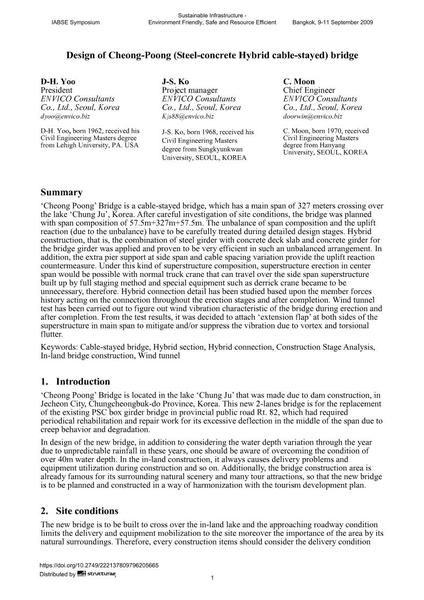Design of Cheong-Poong (Steel-concrete Hybrid cable-stayed) bridge

|
|
|||||||||||
Bibliographic Details
| Author(s): |
D-H. Yoo
J-S. Ko C. Moon |
||||
|---|---|---|---|---|---|
| Medium: | conference paper | ||||
| Language(s): | English | ||||
| Conference: | IABSE Symposium: Sustainable Infrastructure - Environment Friendly, Safe and Resource Efficient, Bangkok, Thailand, 9-11 September 2009 | ||||
| Published in: | IABSE Symposium Bangkok 2009 | ||||
|
|||||
| Page(s): | 63-72 | ||||
| Total no. of pages: | 8 | ||||
| Year: | 2009 | ||||
| DOI: | 10.2749/222137809796205665 | ||||
| Abstract: |
‘Cheong Poong’ Bridge is a cable-stayed bridge, which has a main span of 327 meters crossing over the lake ‘Chung Ju’, Korea. After careful investigation of site conditions, the bridge was planned with span composition of 57.5m+327m+57.5m. The unbalance of span composition and the uplift reaction (due to the unbalance) have to be carefully treated during detailed design stages. Hybrid construction, that is, the combination of steel girder with concrete deck slab and concrete girder for the bridge girder was applied and proven to be very efficient in such an unbalanced arrangement. In addition, the extra pier support at side span and cable spacing variation provide the uplift reaction countermeasure. Under this kind of superstructure composition, superstructure erection in center span would be possible with normal truck crane that can travel over the side span superstructure built up by full staging method and special equipment such as derrick crane became to be unnecessary, therefore. Hybrid connection detail has been studied based upon the member forces history acting on the connection throughout the erection stages and after completion. Wind tunnel test has been carried out to figure out wind vibration characteristic of the bridge during erection and after completion. From the test results, it was decided to attach ‘extension flap’ at both sides of the superstructure in main span to mitigate and/or suppress the vibration due to vortex and torsional flutter. |
||||
| Keywords: |
cable-stayed bridge wind tunnel construction stage analysis Hybrid section Hybrid connection In-land bridge construction
|
||||
